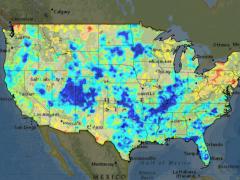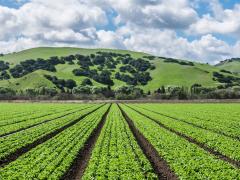What Is Flash Drought? What Can We Do About It?
Takeaways from the NIDIS Virtual Flash Drought Workshop
Flash drought has serious real-world implications. The 2017 Northern Plains flash drought resulted in fires that burned 4.8 million acres and U.S. agricultural losses in excess of $2.6 billion dollars.1 Neither the drought’s swift onset nor its severity were forecasted. Episodes like this have sparked intense interest in flash drought in both the research community and the end user/applications community. Clear conceptualization of flash drought is important to both communities as there are differing understandings and confusion on what flash drought is and how it differs from other droughts. To address this need, NIDIS held a virtual workshop in December 2020 that convened researchers and end users to begin developing a shared understanding/definition of flash drought, and to identify research and tools needed to improve flash drought early warning.
NIDIS organized the workshop with the following objectives:
- Strive for agreement on the basic set of characteristics to which definitions of flash drought should adhere; explore “most useful” flash drought definitions by sector, region, and application.
- Discuss, understand, and document how existing tools and research can be shaped to meet user needs both in the near-term and in the future.
- Develop a list of outstanding research needs in monitoring, prediction, and planning/response to improve early warning.
- Agree upon next steps for this emerging domain and how NIDIS and other partners can support research and coordination.
Over three days of meeting there was broad participation (around 100 attendees each day) and a robust sharing of perspectives through breakout sessions, plenary discussion, and an active chat box. Attendees generally agreed this was a valuable first step in the process of characterizing flash drought and developing a path forward for research. Below are some of the key takeaways. Or, watch recordings of the workshop presentations.
How did workshop participants define and characterize flash drought?
There was agreement that a general framework to define flash drought is necessary. However, any framework requires flexibility in developing specific numerical attributes, indices, and thresholds, given the complexity of the phenomenon and what questions are being asked. Applying this framework will also clarify how flash drought is different from conventional drought.
With a goal of striving for agreement on the basic set of characteristics for flash drought, there was general consensus that the key feature of flash drought is rapid onset/rapid intensification of drought conditions. There is a need for some standardization on how “rapid” is rapid onset/intensification (e.g., rate of change, thresholds). Discussion also focused on the difference between rapid onset and rapid intensification and whether the term “flash drought” should be used for both; i.e., for a rapidly developing event that occurs both during non-drought conditions and one that occurs within the context of a longer-term, slower-evolving drought. It was stressed that the relevance of characterizing flash drought to decision makers and drought managers is that any such rapid change requires a rapid management response.
The workshop participants identified seasonality, regionality, and impacts as key attributes for characterizing flash drought. However, impacts, by themselves, are not the best candidates to serve as leading indicators of flash drought, given the need to provide early warning of flash drought before impacts become evident. It is also important to determine the audience, particularly the end user sector, for whom we are defining flash drought because different audiences (researchers, practitioners, others) may require different definitions.
What indicators of flash drought were identified?
Workshop attendees conveyed that there are many different indicators and indices that can be considered when studying flash drought (Figure 1). However, there is a need for an integrated set of different indicators, given the complexity of the phenomenon and its cascading impacts.
Research should address key indicators that are specific to flash drought. It’s also important to clarify in what circumstances (regions, seasons, etc.) each indicator is of value.

What research/tools are needed to better monitor, predict, respond to, and plan for flash drought?
The workshop focused on three key areas of flash drought research: monitoring, prediction, and planning/response. These different topics were explored both in presentations by research experts and in breakout sessions, and several near-term needs and priorities were identified for each topic, as detailed below.
Monitoring:
- Many tools and data exist that could support flash drought monitoring; however, there is a need to catalog and better communicate these existing flash drought-relevant observations, including their relevance to different seasons or regions.
- “On the ground” information is important and more in situ data is needed (e.g., soil moisture, precipitation).
- Developing an integrated set of key indicators that are specific to flash drought (again including relevance to seasons or regions) is a priority.
- As a related point, researchers need to work with the end user community to extend the analysis of indicators by developing triggers for response actions.
Prediction:
- Research is needed to better understand flash drought predictability. What are the limits in flash drought forecast lead time or spatial resolution? How can current tools push those limits?
- There is a need to coordinate with NOAA prediction groups to develop better atmospheric and land-surface models to improve their prediction products.
Planning/Response:
- Engagement with end users is most important relative to planning and response research needs. Key focus areas of these research needs include:
- What is the best way to communicate about flash drought and its potential implications?
- How does the need for quick action during flash drought change communication channels and protocols?
- How are user needs different for flash drought versus conventional drought?
- How does seasonality affect types of impacts and responses?
Other considerations for effective early warning that were discussed:
A key workshop take-away was the importance of collaboration among researchers and also with end users focused on flash drought. Improved coordination is needed between flash drought monitoring and prediction researcher communities because these two communities often work with similar concepts but on different spatial and temporal scales. By better understanding the spatial and temporal limits and expectations of the other community, synergies can be identified in order to improve early warning capacity. Similarly, there is a need for improved communication between researchers and end users (e.g., fire managers, water utility providers, etc.) to better understand the decisions of these stakeholders as it pertains to flash drought. Intermediary area/boundary organizations such as NIDIS, regional NOAA climate programs, USDA Climate Hubs, and state climatologists who share information between researchers and end users may be important as key translators.
What are some near-term next steps from the Flash Drought Workshop?
- A comprehensive workshop report, detailing workshop outcomes including prioritized research and tool development opportunities, will be published in early 2021.
- Developing a more concrete characterization of flash drought will be a near-term target activity, due to the fact that many potential tools and research opportunities depend upon this.
- Also, there will be additional outreach and forums to incorporate end user community perspectives into future flash drought conversations.
View the workshop agenda and recordings of the presentations on the Flash Drought Virtual Workshop web page.
1. Jencso, K., et al. 2019. Flash Drought: Lessons Learned from the 2017 Drought Across the U.S. Northern Plains and Canadian Prairies. NOAA National Integrated Drought Information System.



